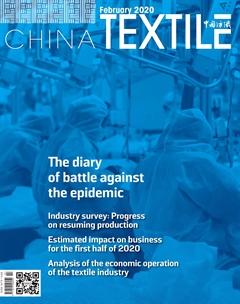Dear readers
The Spring Festival in Chinese Lunar New Year 2020 is dimmed by the outbreak of novel coronavirus, a disease that exploded almost in the same strength and sonority as the firecrackers did in the prime time when China was splendidly celebrating its traditional festivity in late January this year. The whole country was mobilized on an efficient and orderly move to fight the coronavirus, with the rising cases reported on daily basis and declared the Public Health Emergency of International Concerns (PHEIC) by the World Health Organization (WHO) on the last day of January, making it a global emergent event.
While confidence in the containment of this new coronavirus is rising, this public health emergency triggers run on physical supplies in medical and health textiles sector, like gloves, face masks, mouth muffles, hazmat suits and the other protective clothing. The voracious demand for these health gears is hardly fulfilled in time of great need, which runs in shortage as the novel coronavirus broke out when Chinese New Year-Spring Festival was keeping factory workers at home for the traditional holiday, away from the machines and job positions, far and near.
When I engage myself with this letter, the coronavirus situation, once officially declared as “ severe” or “grave”, started to take a turn for the better, which argues well that every cloud has a silver lining.
Although government calls for commencement of production and the other forms of economic activity, to such an extent, that workers are recalled back to factories where working ambience allows for operation, and workers are equipped with protective wear and masks, and workshops are sanitized, it is hard to make up for the loss that occurred during the period of evacuation. According to a COVID-19 “war-time” online survey conducted by Industrial Economy Research Institute, a subsidiary to China National Textile and Apparel Council (CNTAC), the impact on the textile industry in the first half of 2020 is severe and grave because the factories almost stand still for the Spring Festival, as usual, and for the coronavirus-fighting period, in particular.
The report, based on 1201 respondents, is of the view that the first half of the year will see a reduced income by more than 20% in 65.2% of the Questionaired companies, and by 10%-20% in 24.5% of the respondents under survey, as businesses are hard to rehabilitate to the full potential with uncertainties still struggling in two minds whether to take in more orders while workers are not yet available in full number or to wait with inadequate capacity kept running until the situation turns out to be better.
The whole situation starts to look pretty sunny as the new symptomatic cases of the disease continue to drop across the country and the number of workers back to production lines is increasing, and the machines are running in full capacity, the second half of the year will see a fast growth in business to make up for what is lost during the first six months. The impact on export is hard, but not fatal as the coronavirus is. The quick-responding system, cemented with its vertically-integrated industrial value chain and adequate supply of resources, and logistics efficiency, will make sure that the business orders are fulfilled on the basis of good quality , lead time and client-centered services.
Business will return to not where we are, but to where we aim higher. Out of the distress of dark tunnel, we walk into the hope of sunshine.
ZHAO Hong Editor-in-Chief
February, 2020
- China Textile的其它文章
- The diary of battle against the epidemic
- Duan Xiaoping:Firm confidence,adapt to change,win in the future
- How is the progress of all industries in the second week of resumption of work?
- Industry survey:Progress on resuming production
- Survey on the work resumption of 4,650 enterprises in 19 clusters of cotton textile enterprises
- Questionaires survey shows coronavirus impact on Chinese textile industry

